Pontifical Biblical Institute Ancient Language Studies (50 vols.)
Digital Logos Edition
Overview
Immerse yourself in ancient-language texts and detailed Scripture exegesis with the Pontifical Biblical Institute Ancient Language Studies. This 50-volume collection compiles a broad range of works—from interpretation of Scripture to grammatical analysis of Hebrew Poetry, from Aramaic inscriptions to Greek word studies.
The Pontifical Biblical Institute has been publishing critical and instructional texts since it was established by Pope Pius X in 1909. The PBI seeks to “cultivate and promote, by means of scholarly research, the biblical and relevant ancient Near Eastern disciplines, with due respect to the nature of each one of them, in order to obtain ‘a more profound understanding and exposition of the meaning of Sacred Scripture.’” Each volume in this collection serves those same aims, with explorations of Ugaritic, Akkadian, Aramaic, Greek, and Hebrew. Whether you’re a new student of ancient literature or a seasoned ministry professional, gain clarity and depth in your study with this valuable collection.

- Explores Ugaritic, Akkadian, Aramaic, Greek and Hebrew
- Promotes ancient Near Eastern disciplines
- Provides a wealth of ancient language texts well suited for scholars and pastors
- Cultivates a more profound understanding of the meaning of Sacred Scripture
- Title: Pontifical Biblical Institute Ancient Language Studies
- Volumes: 50
- Pages: 15,884
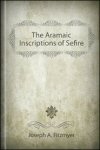
A thorough commentary of the Aramaic inscriptions of Sefire. This revised edition of Joseph Fitzmyer’s classic work also includes transcriptions of all three Steles, a helpful introduction, extensive bibliography, analysis of the grammar of the inscriptions, a list of the names associated with the inscriptions, several indices, and two essays entitled “The Affinity of the Sefire Inscriptions to Hittite and Assyrian Treaties” and “The Land of KTK.”
Joseph A. Fitzmyer is a professor emeritus of biblical studies at the Catholic University of America and resides at the Jesuit Community of the Georgetown University in Washington, DC. His authoritative publications dominate three major areas of research: the New Testament, especially Luke–Acts and the Pauline corpus, Qumran texts and traditions, and Aramaic studies. He has published a compendious edition of Aramaic texts from Qumran and related materials which he coauthored with D.J. Harrington, A Manual of Palestinian Aramaic Texts.
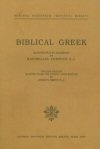
Max Zerwick stated, “The purpose of the present treatise was not so much a purely scientific or philological one, as that of encouraging future ministers of the Word to have recourse to the original Greek text.” Clear and straightforward, Biblical Greek is an excellent discussion of applied grammar, helping students better appreciate the nuances and subtleties of the Greek New Testament. The passages often reference relevant Bible verses.
New Testament scholar Gordon Fee, in New Testament Exegesis, describes Biblical Greek as an “especially useful” text for the study of Greek idioms. Fee recommends Zerwick’s books several times throughout his work. For those seeking to simplify their Greek New Testament exegesis, Biblical Greek is invaluable.
Max Zerwick (1901–1975) is the author of Analysis philoigica Novi Testamenti and Graecitas biblica Novi Testamenti exemplis illustrator, both published by Editrice Pontificio Istituto Biblico.
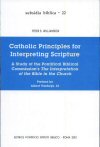
This volume identifies the key principles of Catholic biblical interpretation proposed in the Pontifical Biblical Commission’s document The Interpretation of the Bible in the Church. The meaning of each of these 20 principles is explained and their significance is explored in light of commentary on Scripture and contemporary scholarly discussion. Featuring a preface by secretary of the Pontifical Biblical Commission Albert Vanhoye, the volume also includes a glossary and a bibliography of works about the Commission’s document and of works cited.
Catholic Principles for Interpreting Scripture is split into six parts. Part I considers the foundational principle, that Sacred Scripture is “The Word of God expressed in human language.” Part II addresses the “human language” dimension and the use of “scientific” or scholarly means to interpret it. Part III presents principles which consider Scripture as “the word of God” and relates the interpretation of Scripture to Christian faith. Part IV treats the literal, spiritual, and fuller senses of Scripture. Part V discusses the methods and approaches used by exegesis and the ways in which their use is conditioned by the unique object of their study. Part VI treats the role of the exegete and the theoretical and practical principles that guide actualization, enculturation, and the use of the Bible in the life of the Church. The study concludes with an evaluation of the Biblical Commission’s achievement, an agenda for further discussion, and remarks on the challenge ahead for Catholic exegesis.
The interpretation of Sacred Scripture is of paramount importance for Christian life. Every age of the Church has found it necessary to develop a way of interpreting the Bible that corresponds to the needs and mentality of the time while remaining faithful to the Word of God. As stated in The Interpretation of the Bible in the Church, “The Scriptures belong to the entire Church . . . and all of the members of the Church have a role in the interpretation of Scripture.” Regardless of your denomination, Catholic Principles for Interpreting Scripture will help you take on that role competently and responsibly.
Peter S. Williamson received his MA in theology from Sacred Heart Seminary in Detroit and his STB, STL, and STD in biblical theology from the Pontifical Gregorian University in Rome. He is a married layman who has been involved for nearly 30 years in evangelization and pastoral ministry in the United States, and more recently in Lithuania and Kazakhstan. He presently serves as a mission associate of Renewal Ministries and teaches Scripture at Sacred Heart Seminary in Detroit, Michigan and St. Peter’s Seminary in London, Ontario.
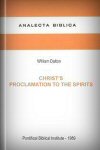
Christ’s Proclamation to the Spirits is a scholarly work particularly noted for its methodology. This second edition takes into account the great deal of work bearing on the interpretation of 1 Peter 3:18–4:6 since the volume’s initial publication in 1965. This includes modifications to the author’s original interpretation, though a substantial amount has been retained.
The work contains a chapter on the authorship of 1 Peter. This involves a discussion of New Testament pseudepigraphy. This approach has made it feasible to find a link between 1 Peter and Peter the apostle. It clearly emerges that 1 Peter, as a precious witness to the faith of the early Church, has its own theology and literary presentation. Within this framework, the difficult texts of 3:19 and 4:6 have to be interpreted.
William Joseph Dalton has taught Scripture in Australia and in many other lands, returning as professor to the Pontifical Biblical Institute and continuing as director of that institute’s branch in Jerusalem. He has been visiting professor on four occasions in the United States. In 1985 he was invited to participate in the Extraordinary Synod of Bishops as theologian. He has published a number of books and articles, mainly in the area of 1 Peter and Pauline studies.
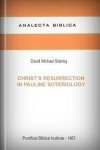
This study presents an aspect which the author believes to be central to the whole of Paul’s thought on the role of Christ as redeemer: the function assigned to Christ’s resurrection in Pauline soteriology. The purpose of this inquiry is not merely to determine the place held by Christ’s resurrection in the more mature expression of Paul’s theology, but also to observe how the progressively deeper understanding of this central Christian truth enabled Paul to arrive at the definitive expression of his conception of Christian salvation. Consequently, it will be necessary to investigate the resurrection of Christ as a formative factor in Paul’s development as it is found reflected in the authentically Pauline epistles preserved in the New Testament canon.
David Michael Stanley entered the Jesuit Novitiate at Guelph in 1933 and was ordained to the priesthood in 1946. After ordination, he was sent to the Pontifical Biblical Institute in Rome. There he completed his dissertation in 1952. For nearly 40 years he taught at various universities across the globe, including Regis College (Toronto), College Immaculee-Conception (Montreal) St.Augustine’s Seminary, Iowa State University, the Pontifical Gregorian University (Rome), Milltown Park (Dublin), and the University of San Francisco. He served as the president of the Catholic Biblical Association of America, the Canadian Society of Biblical Studies, and was elected a member of the Societas Novi Testementi Studiorium. Pope Paul VI named him a member of the Pontifical Biblical Commission.
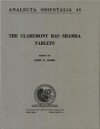
The Claremont Ras Shamra Tablets
- Editor: Loren Fisher
- Publisher: Pontificio Istituto Biblico
- Publication Date: 1971
- Pages: 58
The Claremont Ras Shamra Tablets contains the editio princeps (the first scholarly publication) of six texts—two in Ugaritic and four texts from Ugarit that were written in Akkadian. These texts include photographs of manuscripts, transliteration, translations, and commentary.
Loren Fisher was born March 13, 1927, in Albany, Oregon. Fisher was professor of ancient Near Eastern history at California State University before retiring to dedicate his time to ranching, research, and writing. He has published dozens of articles, essays, books, and poems.
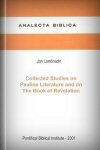
Most of these 30 collected studies were written in Rome. Two are translated from the Dutch; three have not been published previously. Some few studies address philological problems, but most try to explain the thought of the biblical text. There are full-fledged articles and also brief notes. Bringing them together in one volume will prove useful to students of Paul, of Pauline literature, and of the book of Revelation. These essays are the result of years of teaching experience and extensive research.
The reader will find not only analyses of various passages but also broad syntheses of biblical thought. This volume consists of two parts: “Pauline and Deutero-Pauline letters,” the larger one, and “The Book of Revelation,” the smaller. The first part considers Paul’s view of the law, his eschatological convictions, and his reasoning regarding the resurrection of Christ and of the Christians. The second part examines the ecclesiology and the climactic composition of the book of Revelation. The movement from judgments to blessings is carefully investigated.
Jan Lambrecht is a professor emeritus of New Testament and biblical Greek at the Catholic University of Leuven, Belgium. From 1996 to 2001, he was also a visiting professor at the Pontifical Biblical Institute of Rome. He is an internationally known scholar and was a member of the Pontifical Biblical Commission from 1985 to 1995.
His books in English include Once More Astonished: The Parables of Jesus; The Sermon on the Mount: Proclamation and Exhortation, Justification by Faith: The Implications of Romans 3:27–31 (with Richard W. Thompson), and Out of the Treasure: The Parables in the Gospel of Matthew.
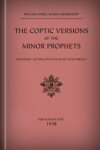
The Coptic Versions of the Minor Prophets presents a critical apparatus for the books of the Minor Prophets in Coptic. Each book has been thoroughly evaluated, with disagreements between the various texts noted and Latin translations offered for certain Coptic terms. The work also features brief introductory comments on each text, as well as thoughtful concluding remarks. This long out-of-print guide to the Minor Prophets will interest all who recognize the importance of the Coptic versions in LXX studies.
The volume is divided into three parts. The introductory Part I deals with the enumeration and description of the Coptic texts of the Minor Prophets, including the Akhmimic, Sahidic, Bohairic, and Fayumic texts. A list of Sahidic quotations are also presented.
Part II is devoted to a collation of Coptic texts. Codex Vaticanus is used as the standard with which the Coptic versions and other Greek MSS are compared. Latin translations of the Coptic variants are also given.
Grossouw has . . . done a fine piece of work, and especially noteworthy is his contribution on the pre-recensional type of Greek text.
—Henry S. Gehman, Journal of Biblical Literature
Willem Karel Maria Grossouw (1906–1990) was a renowned Dutch Roman Catholic author, professor and priest. Widely read in his native Netherlands, he was noted for the progressive views he professed in his works and in public. He began a professorship at Radboud University Nijmegen in 1947, and retired from teaching in 1977. In 1969 he was dismissed from the priestly service for marrying his secretary Wilhelmina Johanna Sophia. His works include Spirituality of the New Testament, In Christ: A Sketch of the Theology of St. Paul and Revelation and Redemption: A Sketch of the Theology of St. John.
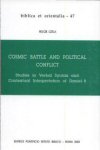
This study offers a fresh appreciation of the various literary elements and genres that constitute Daniel 8 as a whole. Namely, these are the narrative frame, the vision report itself as well as its application to Jewish history under Antiochus IV. While situating the message of this chapter within the book of Daniel, it also shows the importance of the ancient Near Eastern context for the understanding of biblical imagery. In that perspective the work gives a thorough treatment of the syntax of Hebrew verbs and other philological matters that have a special bearing on biblical interpretation. This Monograph makes one of the most challenging biblical texts more accessible to serious students of the Hebrew Bible and the ancient Near Eastern languages in general.
Holger Gzella is professor of Hebrew and Aramaic language and literature at Leiden University Center for Linguistics.

Declaration and Covenant
- Author: Paul Kalluveettil
- Publisher: Editrice Pontificio Istituto Biblico
- Publication Date: 1982
- Pages: 284
Declaration and Covenant is a fascinating examination of covenant formulae from the Old Testament and the ancient Near East. This study shows how covenant partners sometimes created their connection by an oral declaration like the formula: “I am yours, you are mine.” This oral declaration could affect the original covenantal union, or it could reaffirm the existing bond or reestablish a broken pact.
The author develops the argument through an introductory discussion which establishes the specific Old Testament concept of covenant and shows that berît is not the only way to designate biblical covenants. Then he analyzes in detail the nature and function of oral declaration formulae in Joshua 9:8; 1 Samuel 27:12; 2 Kings 10:5–6; and 2 Kings 16:7 in the light of the fullest possible range of ancient Near Eastern examples, including the “Royal Formula” (PN is king) and legal formulae, e.g., of adoption, enslavement, service, and marriage. These non-biblical materials establish five types of formulae found in general use: a generic formula, “We are all one,” and four specific formulae which define the nature of the bond: “vassal-lord,” “father-son,” “brother,” and “friend/ally.”
An important conclusion in the light of current discussion is the affirmation that covenant does convey a primary idea of relationship. Further, the survey of ancient Near Eastern materials is as complete a catalogue of examples as could be gathered. The intrinsic value of such a catalogue is self-evident, and it further serves to confirm that covenant was a relationship.
Paul Kalluveettil was born January 21, 1940, in Trichur, India. He is a member of the indigenous religious Congregation of Carmelite of Mary Immaculate. He was ordained priest on December 1, 1964. He received a MA degree in philosophy and theology from the Pontificium Athenaeum at Poona. The present work is a revised version of the doctoral dissertation which he defended at the Pontifical Biblical Institute in January, 1980. At present he is professor of Old Testament and Semitic religions at Dharmaram Pontifical Institute of Philosophy and Theology, Bangalore, India, and secretary of the Catholic Biblical Association of India.
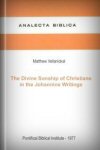
Taking as the determinative concept Jesus’ favorite name for God, Father, John interprets the ideal relationship of men to God as that of spiritual children, having eternal life from the Father. According to John this life of sonship to God—having a definite beginning other than the physical birth, and being manifested in very definite moral and spiritual qualities—defines the very being of a Christian. It is in the measure that one understands clearly, experiences personally, and expounds persuasively this truth of Christian sonship, that one lays hold upon the very heart of Christian faith and life. Hence this investigation of ours to find the formulas, the content and the meaning of the Johannine doctrine of the divine sonship of Christians.
When we start investigating the Johannine doctrine of the divine sonship of Christians, we are confronted with certain questions regarding its nature and origin: Is the Johannine concept of sonship something purely juridical or moral, or does it suppose an ontological reality? If it supposes such a reality, in what does it consist? How do men obtain this reality so as to become children of God? What are the practical consequences of this divine sonship in the life of men? What is the origin of the vocabulary employed by John to express his concept of sonship? Only an attractive study of all the relevant texts in the Johannine writings can provide satisfactory answers to all these questions.
Matthew Vellanickal is the author of Studies in the Gospel of John and Good News and Witness: the New Testament Understanding of Evangelization (with L. Legrand and J. Pathrapankal).
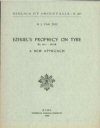
In an attempt to clear up the manifold obscurities and problems with the text of Ezekiel’s Prophecy on Tyre, commentators have mainly resorted to two devices. The first is excessive emendation or interpretation of the Hebrew text on the basis of the ancient versions and especially of the LXX. The second is a literary approach, consisting in cutting out bigger or smaller portions from the text to meet the poetical and metrical requirements favored by the commentators themselves. Fortunately, of late there have been some signs of a new, third method, based on a firm belief in the substantial reliability of the consonantal Hebrew text, and availing itself of the new material of both lexical and syntactical nature uncovered by comparative Canaanite and Semitic studies. Commentators are becoming increasingly convinced that in most cases this is the only method to obtain permanent satisfactory results.
The present writer hopes to make a contribution to the study of Ezekiel’s prophecy on Tyre with the help of the above-mentioned basic methodical principles. He prefers not to take a stand on questions that go beyond the philological and syntactical problems in these chapters. He will center his attention upon controversial points, describing their particular difficulties, referring to the different ways scholars have sought to master the questions, and proposing his own suggestions. In as far as seems desirable, the author will take the liberty of applying these solutions to other biblical texts as well. Moreover, linguistic parallels in Ugaritic and other Northwest Semitic dialects will be discussed at some length. If this study achieves anything, it will prove the soundness of the standard Hebrew text and will illustrate the necessity of having recourse to the other dialects of Northwest Semitic.
H. J. van Dijk was a writer and Hebrew language scholar.
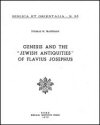
The first and more fundamental purpose of this investigation is to determine both what Josephus has retold of the Genesis narrative in his Antiquities of the Jews, and how he has reshaped what he has retold. The “definition” of the work of a particular author is, however, not quite enough to make such definition sufficiently concrete and graspable. Literary milieu is, therefore, an important and even necessary factor in any attempt to clarify what an author has done. For this reason, both what Josephus has retold and how he has reshaped what he has retold must be to a certain extent measured against a given set of literary parameters. Such “measurement” of both these aspects constitutes the second purpose of this investigation.
References which give a measure to the discoveries respecting what Josephus has retold are drawn from numerous types of sources. Among these may be mentioned at once is the whole body of Alexandrian Jewish literature (including Philo), the Apocrypha (in the narrower sense attributable to the body of literature usually denominated thus), the Qumran literature, the Talmud (in both its forms), Targumim, Pseudepigrapha and Midrashim. Needless to say, some sensible limitation to these references have been decided upon and applied. The problem of limitation of references is resolved in this investigation by the choice of three parameters which will function as the principal sets of references in dealing with what Josephus has retold and as the only sets when there is question of how our author achieved what he did.
Thomas W. Franxman is also the author of The Literary and Exegetical Treatment of Genesis in the Jewish Antiquities of Flavius Josephus, in the Light of Pseudepigraphic, Targumic and Midrashic sources.
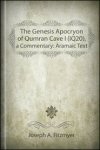
This is the third, revised edition of the standard commentary on the Genesis Apocryphon. This edition has integrated new textual findings, in particular two columns of the text previously considered to be too fragmentary for inclusion. The commentary also evaluates recent scholarly discussion on virtually every part of the text. This edition also presents an updated reference grammar of the Aramaic of the Genesis Apocryphon and a complete glossary. In this respect, the book can also serve as a solid introduction to the study of the Aramaic of Qumran.
Joseph A. Fitzmyer is a professor emeritus of biblical studies at the Catholic University of America and resides at the Jesuit Community of the Georgetown University in Washington, DC. His authoritative publications dominate three major areas of research: the New Testament, especially Luke–Acts and the Pauline corpus, Qumran texts and traditions, and Aramaic studies. He has published a compendious edition of Aramaic texts from Qumran and related materials which he coauthored with D.J. Harrington, A Manual of Palestinian Aramaic Texts.
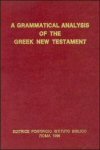
A Grammatical Analysis of the Greek New Testament presents a verse-by-verse analysis of the original Greek New Testament. Breaking down the significant Greek words, it offers parsing, including cross-references to the author’s biblical Greek, notes, glosses, and other relevant information. Grammatical Analysis also provides a succinct interpretation of figures of speech and other explicit or implicit information within the Greek text. The analysis is preceded by a glossary of grammatical terms.
Grammatical Analysis has proven itself an invaluable tool for the student and scholar alike. The hope of author Max Zerwick is that with this analysis, “the Greek text of the New Testament will not remain exclusively a tool on the desks of a decreasing number of specialists but will become a living power in the hands of theologians, of preachers of the Word, of directors of Bible discussion-circles, and finally in the hands of those who pray in private from the Word of God.”
It is clear that the devoted labor of these authors has placed future generations of students—beginners and scholars—in their debt when it comes to brief analytical word-by-word comment on the Greek text and its meaning.
—Paul Elbert, Journal of the Evangelical Theology Society
Max Zerwick (1901–1975), a Jesuit priest, was the author of Analysis philologica Novi Testamenti Graeci and Graecitas biblica Novi Testamenti exemplis illustratur, both published by Editrice Pontificio Istituto Biblico.
Mary Grosvenor’s (d. 1991) linguistic interests began in 1925 when she published A Colloquial English-Chinese Pocket Dictionary in the Hankow dialect. She was awarded the McCaul Prize for Hebrew and the Trench prize for Greek upon graduating BD from King College’s faculty of theology in 1937. She worked on the compilation of the Patristic Greek Lexicon at Oxford University Press before beginning on the English adaptation of Analysis philologica Novi Testamenti Graeci, a project that would eventually take her nine years to complete.
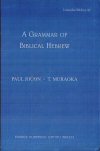
This is the most up-to-date and comprehensive reference grammar of biblical Hebrew. It is the standard required text in many intermediate-advanced Hebrew courses and is an excellent reference for learning Hebrew on your own!
Joüon-Muraoka’s grammar was originally written in French in 1923 but has been recently translated and updated to reflect modern advances in the field. It is frequently cited by lexicons, commentaries and Bible dictionaries (e.g., HALOT, WBC, Anchor). It also makes a great companion to other Hebrew grammars available for Logos Bible Software such as Waltke-O’Connor, van der Merwe, Futato, and Gesenius-Kautsch-Cowley.
Students of the Old Testament, Hebrew, and Semitic linguistics who have a basic knowledge of biblical Hebrew grammar will find much useful insight and information here.
“With regard to both the scope of the present work and the mode of presentation, we have had in mind the ever-growing group of students who feel it necessary to go beyond the stage of purely factual knowledge and wish to develop their ability to resolve the numerous grammatical difficulties of the massoretic text instead of merely bypassing them. They will find here not only all the fundamental concepts, but also most of the details of minor importance. As for the many minute details and anomalies which can make the study of Hebrew such a discouraging undertaking, we have had to set a limit. Besides, what is important for the student is not so much to know a great number of details as to be able to identify an unusual form and to decide whether it is explicable or, having no comparable form, it is anomalous or incorrect. But where it was found that a detail, even the most trivial, could throw some light on some obscure matter, we did not hesitate to note it. One will find here many point of detail not dealt with by E. Kautzsch; on the other hand, some details given by this grammarian have been deliberately left out.”
—Paul Joüon, from the preface to the original French edition
Joüon’s Grammaire, with its fine treatment of syntax, aims at reaching those who desire to advance beyond the beginner’s stage but are not prepared to halt at all minutiae.
F. W. Danker, Multipurpose Tools for Bible Study
. . . remarkably erudite
Douglas Stuart, Old Testament Exegesis
Takamitsu Muraoka was born in Japan and educated at the Tokyo Kyoiku University in English Philology (BA 1960), Greek, Hebrew, and general linguistics (MA 1962), and Hebrew and Semitic Linguistics (PhD 1970) at the Hebrew University in Jerusalem. He taught Hebrew, Aramaic, Syriac, and Ethiopic at the University of Manchester, United Kingdom. (1970–1980). He was professor of Middle Eastern Studies at the University of Melbourne, Australia, teaching those languages (1980–1991). He was professor of Hebrew at Leiden University, the Netherlands (1991–2003). His publications include Emphatic Words and Structures in Biblical Hebrew (Jerusalem/Leiden, 1985), Modern Hebrew for Biblical Scholars, (Wiesbaden, 1998), and A Greek-English Lexicon of the Septuagint (Chiefly of the Pentateuch and the Twelve Prophets) (Leuven, 2002). With B. Porten he also wrote A Grammar of Egyptian Aramaic (Leiden, 2003), Classical Syriac: A Basic Grammar with a Chrestomathy (Wiesbaden, 2005), as well as many other books and articles. Muraoka has recently received the distinction of being elected as an honorary member of the Academy of the Hebrew Language in Jerusalem (2006).

A Grammar of Biblical Hebrew, rev. ed.
- Author: Paul Joüon
- Translator: Takamitsu Muraoka
- Edition: Revised
- Publisher: Pontifical Biblical Institute
- Publication Date: 2006
- Pages: 772
Already well-known in its two-volume first edition, this is the most extensive revision yet of Paul Joüon and T. Muraoka’s Grammar of Biblical Hebrew, one of the most complete Hebrew grammars available in English. The first English edition of 1991 was based on the original work in French by Paul Joüon published for the first time in 1923. This new revised edition brings the work up to the present by taking account of developments in our understanding of the Hebrew language during the intervening years. As with the earlier edition, students of the Old Testament, Hebrew, and Semitics, who have a basic knowledge of Biblical Hebrew, will find much useful insight and information here.
Joüon’s Grammaire, with its fine treatment of syntax, aims at reaching those who desire to advance beyond the beginner’s stage but are not prepared to halt at all minutiae.
—F. W. Danker, Multipurpose Tools for Bible Study
. . . Remarkably erudite.
—Douglas Stuart, Old Testament Exegesis
Takamitsu Muraoka was born in Japan and educated at the Tokyo Kyoiku University in English Philology (BA 1960), Greek, Hebrew, and general linguistics (MA 1962), and Hebrew and Semitic Linguistics (PhD 1970) at the Hebrew University in Jerusalem. He taught Hebrew, Aramaic, Syriac, and Ethiopic at the University of Manchester, United Kingdom. (1970–1980). He was professor of Middle Eastern Studies at the University of Melbourne, Australia, teaching those languages (1980–1991). He was professor of Hebrew at Leiden University, the Netherlands (1991–2003). His publications include Emphatic Words and Structures in Biblical Hebrew (Jerusalem/Leiden, 1985), Modern Hebrew for Biblical Scholars, (Wiesbaden, 1998), and A Greek-English Lexicon of the Septuagint (Chiefly of the Pentateuch and the Twelve Prophets) (Leuven, 2002). With B. Porten he also wrote A Grammar of Egyptian Aramaic (Leiden, 2003), Classical Syriac: A Basic Grammar with a Chrestomathy (Wiesbaden, 2005), as well as many other books and articles. Muraoka has recently received the distinction of being elected as an honorary member of the Academy of the Hebrew Language in Jerusalem (2006).
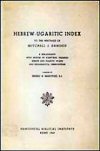
Hebrew-Ugaritic Index to the Writings of Mitchell J. Dahood, vol. I
- Editor: Ernest R. Martinez
- Publisher: Pontificio Istituto Biblico
- Publication Date: 1967
- Pages: 120
These two volumes provide an index to all the Scripture references, words and grammatical functions discussed in the collected writings of Mitchell Dahood related to Ugaritic and the Hebrew Bible. In addition to indexing the writings of Dahood, pertinent reviews, related dissertations written by his students, and other relevant works are also indexed. Dahood was one of the most prolific writers on Ugaritic-Hebrew studies, and these volumes make it easier to locate what he had to say on many passages and words.
Ernest R. Martinez is a professor at Pontifical Gregorian University in Rome. He is also the author of The Gospel Accounts of the Death of Jesus.
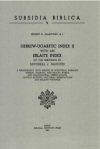
Hebrew-Ugaritic Index to the Writings of Mitchell J. Dahood, vol. 2
- Editor: Ernest R. Martinez
- Publisher: Pontificio Istituto Biblico
- Publication Date: 1981
- Pages: 161
These two volumes provide an index to all the Scripture references, words and grammatical functions discussed in the collected writings of Mitchell Dahood related to Ugaritic and the Hebrew Bible. In addition to indexing the writings of Dahood, pertinent reviews, related dissertations written by his students, and other relevant works are also indexed. Dahood was one of the most prolific writers on Ugaritic-Hebrew studies, and these volumes make it easier to locate what he had to say on many passages and words.
Ernest R. Martinez is a professor at Pontifical Gregorian University in Rome. He is also the author of The Gospel Accounts of the Death of Jesus.
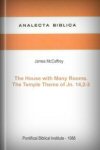
The text of John 14:2–3 bristles with difficulties. It describes the redemptive work of Christ in terms which pertain to the family and its intimate personal relationships. However, careful examination also reveals significant temple implications. The text states equivalently that the New Temple of the risen Jesus is the way of access to the heavenly temple of the Father’s house. Moreover, the term “place” is taken to mean sanctuary or temple.
Extensive arguments support this interpretation by the use of a method which distinguishes two levels of meaning in the text, a pre-Paschal and a post-Paschal respectively. Part 1 of this study treats directly of the Jewish background, with a preliminary chapter which opens up the rich possibilities of the text. Part 2 deals with the Johannine context, the deeper post-Paschal meaning, and the links with other Johannine temple texts. A final chapter shows the unity between the two levels of understanding. Such an interpretation points to the temple as an important theme of the Johannine farewell discourses which cannot be adequately explained without reference to it.
James McCaffrey has lectured widely in India, Israel, Philippines, Australia, New Zealand, Papua New Guinea, and the United States. He has also contributed articles and written several books on biblical topics. At present he is a lecturer and tutor at Ushaw College, Durham University.
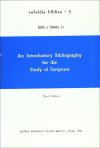
An Introductory Bibliography for the Study of Scripture presents an annotated list of scholarly works, perfect for the student beginning a study in one of the many Scripture-related disciplines. Joseph Fitzmyer has gathered together the greatest titles in biblical literature and briefly describes each work. He presents only those resources which will be best suited to each particular field of study.
Each title is organized into convenient categories. These categories, each one comprising their own chapter, include grammars, concordances, commentaries, geography, history, hermeneutics, and many others. Every basic discipline related to scriptural studies is here represented. The titles are ordered alphabetically in each category subdivision. The more important ones are listed with an asterisk, and the most important with two asterisks.
Becoming oriented in the vast array of materials available for the study of Scripture can be a daunting task. The student can easily find themselves at a loss trying to decide where to discover the standard, reputable titles and authors in their chosen discipline. With An Introductory Bibliography for the Study of Scripture, readers now have access to the best primary and secondary titles available.
[O]ne can readily benefit from an interaction with the works included by this first rate biblical scholar.
—Michigan Theological Journal
Joseph A. Fitzmyer is a professor emeritus of biblical studies at the Catholic University of America and resides at the Jesuit Community of the Georgetown University in Washington, DC. His authoritative publications dominate three major areas of research: the New Testament, especially Luke–Acts and the Pauline corpus, Qumran texts and traditions, and Aramaic studies. He has published a compendious edition of Aramaic texts from Qumran and related materials which he coauthored with D.J. Harrington, A Manual of Palestinian Aramaic Texts.
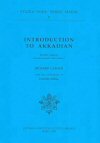
Introduction to Akkadian offers a 12-lesson course in the essentials of Akkadian grammar. The lessons feature concise explanations of Akkadian grammar, as well as exercises in reading, transliteration, and translation. These introduce the student to common vocabulary and basic cuneiform signs. In addition, Introduction includes appendices dealing with Akkadian phonetics and metrology, indices, and a paradigm of the strong verb.
Richard Caplice (b.1931) is the author of Introduction to Akkadian published by Editrice Pontificio Istituto Biblico and The Akkadian Namburbi Texts: An Introduction published by Undena Publications.
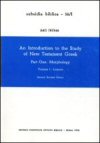
These two volumes are the culmination of the many decades James Swetnam spent teaching elementary Greek at the Pontifical Biblical Institute in Rome. They are designed specifically for those who wish to study New Testament Greek without the aid of a teacher.
The text is constructed around 100 lessons, with 67 comprising the basic grammar, 14 lessons discussing grammatical items, and the last 19 lessons being devoted to reading from the biblical text. It presumes that the beginner knows nothing about the Greek alphabet or the traditional categories of grammar which come from the Greco-Latin heritage. These categories are explained as the Greek of the New Testament is introduced.
In keeping with the author’s aim to give the student maximum exposure to the sacred text, the Greek text of Mark’s Gospel is tackled in the very first lesson. The rest of that Gospel, as well as the entire Gospel of John, are thoroughly examined over the course of the lessons. The second volume contains a key to these exercises, as well as helpful paradigms and indexes. This enables the student to see how morphological forms and vocabulary words fit into the language as a whole.
. . . by far the most comprehensive introductory volumes that I have ever read.
—Stanley E. Porter, Greek scholar
James Swetnam, a native of St. Louis, Missouri, is professor emeritus at the Pontifical Biblical Institute where he has been stationed since 1962 as teacher, administrator, editor, and writer. He holds degrees in classical languages, philosophy, theology, and Scripture. His area of specialization is the epistle to the Hebrews.
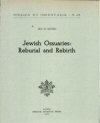
The question of the meaning and origin of Jewish ossuaries has long held the attention of the scholarly world. Since the vast majority of Jewish ossuaries come from the latter part of the Second Temple period they constitute one of the most important bodies of evidence for the recovery of the Judaism of that period. Their style, their inscriptions, the burial procedures they require, all are matters that now must be taken into account. This study takes a relatively new approach to the problem of ossuaries labored under the false hope that all questions regarding Jewish ossuaries could be answered within the context of Hellenistic-Roman society in Palestine and abroad. However, noted Israeli scholar L. Y. Rahmani broadens the scope of the study of Jewish ossuaries to include the bone-collecting practices of the First Temple period (Iron II). The present work follows his lead in this respect.
Because Jewish ossuaries for quite some time were not studied in a broader context, the practice of secondary burial which underlies the phenomenon of Jewish ossuaries was thought to be unrelated. So little noticed was the long-standing custom of gathering bones after decomposition that the most expert commentators have remarked: “It is not clear from whom the Jews took this strange custom, which is indeed alien to the spirit of the Semitic peoples to whom disturbing the deceased was prohibited;” or “no proper indication has been given on the religious-historical plan of this burial-custom which is alien to the Jewish tradition.” It would be strange indeed for Jews to adopt a mode of burial which had no prehistory in Palestine, especially in light of Halachic prohibitions against contact with the dead or remains of the dead. To find secondary burials in wide usage before Hellenistic-Roman times, therefore, is an important clue to unraveling the history of Jewish ossuaries, which do not emerge in a vacuum or begin as a result of outside borrowing.
Eric M. Meyers is a biblical scholar and archaeologist from Duke University in Durham, North Carolina. Eric serves as the president of the prestigious American Schools of Oriental Research.
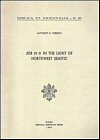
Despite their importance for Old Testament study in general and for the book of Job in particular, Job 29–31 contain a number of recognized and unrecognized difficulties for translators and commentators. The present study proposes to use the comparative method of Northwest Semitic philology to make these three chapters of Job more understandable. The Northwest Semitic approach, which depends on Eblaite, Ugaritic, and Phoenician for help in elucidating the text, has already proven itself a valuable tool in providing new insights into and solutions for more difficult selections of Hebrew poetry. The approach has brought to light new elements of Hebrew lexicography, grammar, syntax, style, and mythological background. This volume collects what has been done thus far on chapters 29–31 using this approach and suggests new translations for difficult verses.
Anthony R. Ceresko (1942–2005) was an Old Testament scholar.
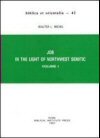
This book ventures to close a gap in recent studies on Job. Since the discoveries of the texts at Ugarit (1929) and at Ebla (1974) hundreds of new suggestions have been made for the understanding of Job based on these texts by a number of scholars, and especially by M. Dahood. All areas of ancient Hebrew are affected: orthography, lexicography, grammar, syntax, and poetic devices.
The present work attempts to present a comprehensive study with particular emphasis on the collection, summary and discussion, in one convenient place, of the many contributions which M. Dahood has made in his 30-year long publishing career. Among the methodological principles, the most important are the aims: 1) to understand the consonantal text without recourse to emendations or transposition of consonants, words, lines, or verses; 2) to recover previously unrecognized mythological references or allusions, especially names and epithets of God and the forces of death; 3) to produce a literal and still sensible translation into English. After an introduction the translation is followed by notes, a bibliography and thorough indexes.
Walter L. Michel is an associate professor of Old Testament at the Lutheran School of Theology in Chicago. He received his theological training at the Universities of Vienna and Heidelberg, where G. Fohrer and G. von Rad were among his teachers. He served as a teacher of religion in the public schools in Vienna, as a parish pastor in Illinois, and as a campus pastor at the University of Wisconsin-Madison.

New Testament authors expressed the essence of Christianity in one word. It is the Greek word koinōnia usually translated as “fellowship.” St. Paul reduces the whole Christian vocation to a koinōnia when he writes “God is faithful, by whom ye were called unto the fellowship (koinōnia) of his Son Jesus Christ our Lord” (1 Cor. 1:9). St. Luke uses the same term to depict the life of the first Christians: “And they continued steadfastly in the apostles’ doctrine and fellowship (koinōnia), and in breaking of bread, and in prayers” (Acts 2:42). 1 John goes a step further and affirms “That which we have seen and heard declare we unto you, that ye also may have fellowship (koinōnia) with us: and truly our fellowship is with the Father, and with his Son Jesus Christ” (1 John 1:3). Fellowship with Christ, leading to a fellowship with the Father, and fellowship with one another in Christ: there you have Christianity in one word.
Interesting studies on the term koinōnia have appeared from the 1930s onward. But almost all the works on koinōnia which have been encountered are concerned with the discussion of the philological aspects of the word koinōnia. Using these works as a basis, the author attempts in this study to find the theological implications of the New Testament koinōnia. The depth and beauty of the New Testament koinōnia could serve as guidelines to a new ecclesiology, resulting from an enriched Christology.
George Panikulam was born in Puthenchira on October 26, 1943. After his school education he joined St. Mary’s Minor Seminary in Thope, Thrissur. His major seminary formation was in St. Joseph’s Pontifical Seminary in Aluva. His priestly ordination occurred in 1967. After the one year service at Lourde Cathedral, Thrissur as the assistant vicar, he was sent to Rome for higher studies. He secured a doctorate in Scripture and did post graduate studies in canon law and sacred theology. Later he joined the diplomatic service of the Vatican. While serving as the Vitan observer in the UNO, he was nominated Titular Bishop of Arpaia in Rome and the Apostolic Nuncio of Honduras. He was ordained as the archbishop in Rome by His Holiness Pope John Paul II in 2000.
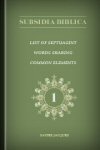
This substantial concordance of Septuagint words is a well-known tool for referencing Septuagint vocabulary and word use. Use it to expand your dictionary, lexicon, or concordance, and get the most out of your Greek research, philology, or word studies.
Xavier Jacques is a graduate of Pontifical Biblical Institute.
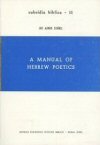
A Manual of Hebrew Poetics is a helpful guide for analyzing Hebrew poetics. The volume’s primary purpose is not to serve as a source of information about facts and authors but, rather, to initiate the reader into the stylistic analysis of poetry. Everything that this manual contains by way of definition, description, or classification is given as a means to doing analysis. For this reason, many of the chapters and sections either begin or end with an example of analysis. The manual is not primarily a reference book but, instead, a volume of initiation into the practice of analysis. Among the poetic techniques discussed are sound and sonority, rhythm, imagery, figures of speech, dialogue and monologue, development, and composition.
Luis Alonso Schokel (1920–1998) was born in Madrid. In 1935, he entered the Society of Jesus in Belgium. He studied classical literature at Salamanca, philosophy at Ona (Burgos), and theology at Comillas. From 1951 to 1957, he studied Scripture at the Pontifical Biblical Institute in Rome and received licentiate and doctoral degrees. From 1957 to 1995, he was a professor of sacred Scripture at the Institute, and he lectured widely in Europe, the Americas, and Asia. He authored many books and articles.
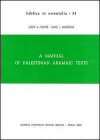
A Manual of Palestinian Aramaic Texts gathers together Palestinian Aramaic texts of various sorts and varying lengths from the last two centuries BC and the first two centuries AD (roughly 200 BC to AD 135). It presents the kind of Aramaic used in Palestine during this period. Discussions of the language of Jesus in recent decades have been legion, and much of that discussion has been based on texts that are of questionable relevance. The authors’ purpose in gathering the Palestinian Aramaic texts of this period is to illustrate what should be the background to that discussion.
The texts are of diverse character: a few of them are biblical (revealing the form of the text in this period); a number belong to the so-called intertestamental literature of Palestinian Jews; some of them are letters, contracts, or business documents of different sorts, reflecting various elements of Palestinian life of that period. The last part of the collection of texts presented here comes from ossuaries or tombstone inscriptions and often contains no more than a few words or names. Indeed, it is not at all easy to decide whether such texts are really written in Aramaic (and not in the Hebrew of the day). They are included here only to the extent that they have something in them that may indicate an Aramaic relationship.
A Manual of Palestinian Aramaic Texts provides the text of these documents (often with emendations and restorations, to the extent that these are possible), a translation of the text, a brief introduction, and a bibliography of secondary literature on each of the texts. A glossary of the texts completes the collection.
Joseph A. Fitzmyer is a professor emeritus of biblical studies at the Catholic University of America and resides at the Jesuit Community of the Georgetown University in Washington, DC. His authoritative publications dominate three major areas of research: the New Testament, especially Luke–Acts and the Pauline corpus, Qumran texts and traditions, and Aramaic studies. He has published a compendious edition of Aramaic texts from Qumran and related materials which he coauthored with D.J. Harrington, A Manual of Palestinian Aramaic Texts.
Daniel J. Harrington is professor of New Testament at Weston Jesuit School of Theology. In addition to serving as editor of New Testament Abstracts, he teaches courses in both the Old and the New Testament. His research focuses on biblical interpretation in antiquity, modern biblical interpretation, and the relation between exegesis and preaching. He has written over 30 books.
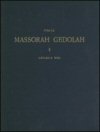
The Massorah Gedolah, also known as the Masorah Magna (Mm), contains the Hebrew Bible’s upper and lower marginal notes. The marginal notes (known as Masorah, meaning “to hand over” in Hebrew) consist of instructions designed to preserve the text, maintaining a form of quality control by which the texts could avoid significant change. The Mm specifically presents references to the verses where a particular text feature occurs. As opposed to giving chapter and verse, the Mm identifies excerpts: each verse or passage annotated by an Mm note is identified by a brief excerpt from it. The editor includes chapter and verse references to the lists in Massorah Gedolah, so you don’t have to recognize a verse by the short quotation. Study of the Masorah can benefit both the scholar and the student. For instance, the Biblia Hebraica Stuttgartensia apparatus contains extensive citations to the Mm, so any study of the BHS would be aided by the Massorah Gedolah. A better understanding of the Tiberian text can be obtained by mastering the Masoretic notes, helping the scholar become more familiar with what constitutes a standard tradition. Study of the Masorah can also aid the student’s movement past technical matters of grammar and textual tradition, as the Masorah was a simple form of literary criticism.
Note: This resource is in Hebrew with a French/Hebrew introduction.
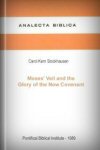
This study analyzes a single Pauline text of exceptional difficulty and importance, 2 Corinthians 3:1–46, from the point of view of its logical and literary structure as it can be discovered from the apostle’s use and interpretation of a network of interrelated Old Testament texts. These Scripture texts, recovered through Paul’s vocabulary, are linked and used by him according to exegetical methods common in his time. As his own exegesis is reappropriated in this study, the reader is able to see the mind of the apostle at work in his own religious context. The origins of such fundamental Pauline theological themes as the new covenant in Christ, the gift of God’s spirit to a recreated people and the hardening of Israel into disbelief are explained through the creative interweaving of texts. Finally, the unity and authenticity of a much disputed Pauline text are reaffirmed in this study on literary and exegetical grounds. The text is discussed according to its two major traditional segments, 3:1–6 and 3:7–18, comprising the two major chapters of this work. An introduction prepares the reader for the methodological approach, exegetical criticism, taken in this book, and a conclusion interprets 2 Corinthians 4:1–6 in light of the new information provided by the present inquiry and discusses further with an index of modern authors and an index of scriptural references.
Carol Stockhausen received her BA in theology and philosophy from Marquette University in 1969 and her PhD in religious studies, with a specialization in Christian origins and New Testament literature, also from Marquette in 1984. Since 1984, she has been a member of the faculty and the director of graduate students in the department of theology at Marquette University. She is a member of numerous professional societies in the United States and internationally. She is the author of a work on Colossians, Ephesians, and the Pastoral Epistles, entitled Letters in the Pauline Tradition.
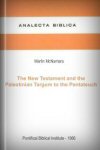
In this study, the author aims to determine whether the Palestinian Targum, when approached from various angles, shows a definite relation with the New Testament, one that is not found in rabbinic writings. It will be evident that there is no intention of attempting to prove that every text of the Palestinian Targum is of pre-Christian date. Even a moderate knowledge of the Palestinian Targum will indicate that there are at least some passages from the centuries after the time of Christ. The author intends, however, to propose arguments from the New Testament and rabbinic writings which indicate an early, even pre-Christian, date for the bulk of the material of the Palestinian Targum. It may be objected that this method is of scant value for New Testament exegesis, seeing that any individual text of the Palestinian Targum could be a later date. The author grants that there still will remain the necessity of studying individual Palestinian Targum texts in depth. This, nonetheless, in no way invalidates the method followed in the volume. If it is possible to show that there is a manifold relation between the Palestinian Targum and the New Testament than the author has established a strong argument for the pre-Christian date of the Palestinian Targum as such. Exegetes can thus legitimately turn to Palestinian Targum when they seek the elucidation of some obscure New Testament text.
Martin McNamara is the author of several books, including Apocalyptic and Eschatological Heritage: The Middle East and Celtic Realms, The Apocrypha in the Irish Church, Intertestamental Literature, and editor of The Aramaic Bible: Targums in Their Historical Context (with D. R. G. Beattie).
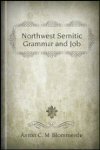
This study is chiefly concerned with some grammatical peculiarities which either have been discovered for the first time in Ugaritic or Phoenician and afterwards also in Hebrew, or were already known from Hebrew but have received renewed attention under the impulse of Northwest Semitic studies. In two sections, the study tries to shed new light on a series of passages from Job by applying these grammatical principles.
In the first section, entitled “Northwest Semitic Grammar and Hebrew,” the author gives a brief survey, with bibliography, of the grammatical phenomena in the texts from Job, which is discussed at greater length in the second section. The second section, “Northwest Semitic Grammar and Job” deals with a series of passages from Job, one by one, following the order of the biblical texts; it applies to individual texts the grammatical principles discussed in the first part.
Anton C. M. Blommerde was a writer, translator, and linguist.
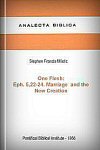
The address to wives in Eph. 5:22–24 represents an expansion of Col. 3:18. What guided the expansion? An answer emerges from an investigation of Pauline and Jewish reflection about Adam, Christ and the New Creation. The argument of the study is that Eph. 5:22–24 contains language which elsewhere in the Pauline corpus associates Christ with Adam or the first two chapters of Genesis. Both the “adamic” character of the language in Eph. 5:22–24 and the application of Genesis 2:24 to Christ and the church (Eph. 5:31–32) support the contention that Pauline New Creation theology guided the construction of Eph. 5:22–24.
The first chapter outlines the shortcomings of previous investigations which have underestimated the “adamic” character of Ephesians 5:22–24. Chapter two contains a detailed analysis of the grammatical structure of the text, which leads to the conclusion that the logical and theological core of the text is Ephesians 5:23c (“he, savior of the body”). The arguments in the next chapter demonstrates that the soteriology of 5:23c is to be interpreted in light of 2:14–18, which recasts Christ’s death on the cross in language found in Genesis 1–2, suggesting the “adamic” character of 5:23c.
The fourth chapter explores the “adamic” nature of the terms “head” and “subordination” within Pauline texts prior to Ephesians (e.g., 1 Corinthians 11:2–6; 15:28b; Colossians 1:15–20). The final chapter contains a fresh exegesis of Ephesians 5:22–24 in light of Pauline New Creation theology and some brief hermeneutical reflections.
Stephen Francis Miletic was born in Windsor, Ontario, Canada in 1952. After studying music at the Academy for Music and Performing Arts in Vienna (1971–1973) he earned degrees in religious studies (BA, MA) from the University of Windsor, a PhD in religious studies from Marquette University (Milwaukee, 1985) and a BEd from the University of Windsor (1978). He has presented papers to professional biblical associations in both the United States and Canada. He has taught as a visiting assistant professor in the United States and as a lecturer in Canada. In 1986, he served as the director in the National Office of Religious Education, Canadian Conference of Catholic Bishops, Ottawa.
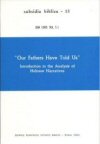
“Narratology” is a recent method of literary criticism adopted by exegetes for the analysis of Old Testament narratives. The aim of this introduction is to help the student find a way through the forest of new terms used by specialists and to give numerous examples of texts analyzed according to this new methodology. The work also contains, as far as possible, references to the origin of the terminology, to basic works in the field, to interesting discussions, and to different schools in literary criticism. Moreover, this manual tries to open a forum for a constructive dialogue between exegetes using more classical methods and those who favor this new way of exploring the well-known landscape of Scripture. The principal notions explained and illustrated are story, time, plot, narrator and reader, character, and point of view.
Jean Louis Ska is a professor at the Pontifical Biblical Institute in Rome.
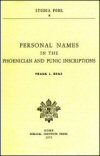
In the 130 years of study in the Phoenician-Punic corpus of textual material prior to this study’s publication, no comprehensive catalog of the personal names has ever been prepared. The impressive personal name studies of other Semitic tongues beg for a companion in the Phoenician-Punic area. The study presented here aims to fill that need.
Incorporating all the known published Phoenician, Punic, and Neo-Punic inscriptions available at the time of this volume’s publishing, chapter 1 lists the relevant bibliographies of those inscriptions. A key to the Phoenician-Punic inscriptions, utilizing publication symbols or titles of inscriptions, has been adopted for use in recording name occurrences. The second chapter catalogs the legible or restorable names listed in Hebrew alphabetic order together with reference to every occurrence. The foreign names are listed separately for convenience in locating them. Chapter 3 brings together the majority of those names which are homogeneous by structure or type. Finally, in chapter 4, a glossary containing every element (with brief commentary and bibliography where possible) is given. Under each element are listed the names, including the variant and misspelled examples in which the given element occurs. Instances of vocalized names from other language sources conclude the glossary entries.
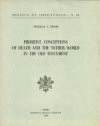
Death is a vital issue in the Old Testament. This appears both from the innumerable allusions to the reality of death and its consequences, and from the numerous studies devoted to the subject since the rise of modern critical exegesis. As the results of this research are sufficiently well known, a summary of them is not called for; and a fresh analysis of established positions would amount to a series of repetitions. A new approach is imperative to justify another study of our theme. This fresh starting-point was found in Ugaritic literature. The special value of Ugaritic texts consists in their language, which shows a remarkable similarity with biblical Hebrew, both in vocabulary and style. This dissertation intends to show how the application of the fruits of Ugaritic scholarship can make a valuable contribution to the study of Israelite conceptions about death and the hereafter.
In the first place this contribution is of a linguistic nature: it attempts to use the results of philological research on the Ugaritic texts and its application to biblical literature. Secondly, it tries to obtain a better perspective of Israelite views on death and the beyond with the help of conceptions found in these texts. Above all things, this study attempts to take advantage of the results obtained by the philological research of the Ugaritic texts and its application to biblical literature.
Nicholas J. Tromp is also the author of Over Psalmen Gesproken and Psalmen 1–50.
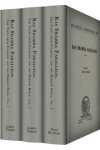
Ras Shamra Parallels: The Texts from Ugaritic and the Hebrew Bible (3 vols.)
- Publisher: Pontificio Istituto Biblico
- Publication Date: 1972–1981
- Pages: 1,663
These outstanding volumes form a bridge between Ugaritic studies and biblical studies. The Ras Shamra Parallels describe and index features in the Ugaritic tablets that shed some light on the Hebrew Bible. Features indexed include: poetic parallel pairs, professions, institutions, political and foreign affairs, literary genres, place names, words, phrases, flora, fauna, minerals, divine names and narrative structures.
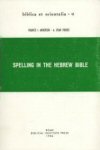
Spelling in the Hebrew Bible attempts four things: first, it describes the orthographic phenomena of the Hebrew Bible; second, it assesses the evidence by means of appropriate statistical analyses; third, it interprets the evidence in terms of the history of Hebrew spelling; finally, it speculates on the significance of this evidence for studies in the production and transmission of the text.
Francis Andersen is a professor of studies in religion at the University of Queensland. He earned his PhD at the John Hopkins University. His main interests in Scripture studies are the linguistic aspects of biblical Hebrew.
A. Dean Forbes manages speech recognition research at Hewlett-Packard Laboratories. He earned his degrees from Harvard and the Pacific School of Religion. His interests include computer-assisted research in linguistics.
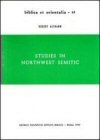
The late Mitchell Dahood, lecturer in Northwest Semitic languages at the Pontifical Biblical Institute from 1956 to 1982, made numerous and often very original suggestions for interpreting the Hebrew text of the Old Testament. His proposals provoked much controversy at the time. Fifteen years after his sudden death, it seemed appropriate to consider some of them again with a view to establishing how far they may be judged plausible. It is not always possible to attain definite conclusions in these matters, but the process of learning and discovery requires summing up from time to time so that the way forward may be more clearly seen. It is hoped that this monograph will contribute to the ongoing task of interpreting the sacred text.
Robert Althann completed theological studies at Heythrop College in London and at the Pontifical Biblical Institute after which he taught sacred Scripture at the Regional Seminary of Zimbabwe and at the University of Zimbabwe. The same university awarded him a DPhil for a study of chapters 4–6 of the book of Jeremiah, published in this series during 1983. From 1989 to 1991, he was a visiting lecturer in the Old Testament at Hekima College in Nairobi. Since then, he lectures in biblical Hebrew at the Pontifical Biblical Institute.
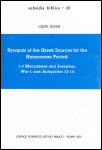
This volume offers a synopsis of 1 and 2 Maccabees in Greek. It includes not only all parallel sections of these two books but also Books 12–14 of Josephus’ Jewish Antiquities to the extent that they are paralleled in 1 Maccabees or in the Jewish War. Thus, the major sources for the history of Palestine from 175 to 37 BCE are made available here together for the first time in electronic form.
The synopsis aims primarily to serve as a basic tool for the literary and historical analysis and comparison of the texts included. It shows, in most cases unequivocally, how the texts, arranged here in parallel columns, deal in different fashion with the same or similar events. It also makes transparent where they follow the same or similar outline, share words and phrases—sometimes even entire sentences.
Synopsis of the Greek Sources for the Hasmonean Period assists the researcher in identifying and comparing different types of relations between various sections of these texts. Additions and omissions stand out immediately, but also passages rewritten in a more or less biased fashion are more easily identified than if one had to use each text separately. Furthermore, the synopsis may be useful as a tool for comparing the similarities and differences not only of content but also of style between the War and Antiquities, especially in passages where the parallels are particularly close.
This synopsis will be a valuable tool for scholars and students working with the books of Maccabees and/or with Josephus, and for those interested in various forms of intertextuality.
Joseph Sievers was born in Germany in 1948. He began his studies at the University of Vienna and at the Hebrew University. He holds a PhD in ancient history/Hebrew studies from Columbia University and a licentiate of theology from the Gregorian University. He has taught ancient History at the City University in New York, Jewish History at Seton Hall University, and New Testament Greek at the Pontificio Ateneo S. Anselmo. Since 1991, he has taught Jewish history and literature of the Hellenistic period at the Pontifical Biblical Institute. Among his publications are The Hasmoneans and Their Supporters: From Mattathias to the Death of John Hyrcanus I, and Josephus and the History of the Greco-Roman Period: Essays in Memory of Morton Smith which he coedited with Fausto Parente.
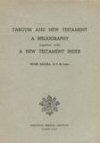
Targum and New Testament: A Bibliography Together with a New Testament Index
- Author: Peter Nickels
- Publisher: Editrice Pontificio Istituto Biblico
- Publication Date: 1967
- Pages: 88
Targum and New Testament collects a bibliography of some of the most useful books and articles on the Targums, and pinpoints their interaction with the New Testament in a helpful index. The purpose of the bibliography is to acquaint, or further acquaint, exegetes with the work that has been done in the field of Targum-New Testament relationships. The titles listed here represent a variety of approaches to the question of relations between the Targums and New Testament. There are the linguistic, the form critical, the thematic or more strictly dogmatic. The titles of the works will in many cases indicate the author’s approach. The bibliography is testimony to the varied riches which Christians will find in Targumic literature.
The criterion in gathering titles for the following bibliography was a use of Targumic material in treatment of a New Testament text or theme. Works which treat solely of the Targums, their origin, date, etc., have not been included. Entries in dictionaries and encyclopedias have also been omitted.
The second part features an index of New Testament texts whose translation or interpretation has been related to Targumic literature. It will interest the student of textual criticism, as well as the exegete with his varied tools and methods. In order to render the index more immediately useful, a few words of explanation are added to nearly every entry.
Peter Nickels (1934–2012) was a Conventual Franciscan in the order of Catholic Friars since 1952. He studied in the United States and Rome, and was ordained a priest in 1960. Father Nickels served in parishes thoughout the US. He was also a professor of theology, a missionary in Zambia, Africa, a translator, and a writer.
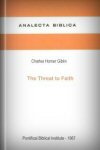
The task of presenting theologically oriented exegesis must precede the professional popularization of new interpretations, the writing of standard commentaries, and a number of other aspects of biblical studies. The author aims to fill a notable gap in this respect by offering to scholars what should be the first exegetical monograph concerning 2 Thessalonians 2 as a whole.
The chapter itself is by no means an unattractive one. It invites the scholar to scrutinize its many specific exegetical problems in terms of the Gestalt of difficulties which it presents, including its precise theological and pastoral orientation. By way of providing a special incentive for laborious investigation, the chapter obviously contains a rich lode of eschatological teaching, one of the basic currencies of present-day theological discussion.
Part 1 investigates the state of the question; part 2 contains the exegesis of 2 Thessalonians 2 and concludes with a commentary on the whole of that passage; part 3 presents fuller theological reflections consequent on the exegesis. For the reader with initially less time at his disposal, the schematically arranged text and translation at the end of part 1 together with the resumes and the overall commentary in the last chapter of part 2 should provide a good grasp of the new interpretation the author submits.
Charles Homer Giblin was born in Chicago and attended Loyola Academy with the aim of becoming a Jesuit priest. He entered the Jesuit novitiate at Milford, Ohio in 1945, and ultimately obtained a bachelor’s degree in Latin and a master’s in Greek from Loyola University, as well as teaching degrees in philosophy and theology from the old West Baden College in Indiana. Following his ordination, he earned a doctorate from the Pontifical Biblical Institute in Rome. He taught theology at Jesuit schools in Illinois, Michigan, and Ohio before joining the faculty at Fordham in New York City. He has authored a number of scholarly articles and books, particularly on the subjects of St. Paul and St. John.
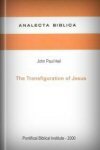
This is the first monograph devoted to all three accounts of the transfiguration of Jesus from a narrative-critical, audience-oriented perspective. It proposes a new literary genre designation for all three versions, that a “pivotal mandatory epiphany,” based upon the precedents in Numbers 22:31–35, Joshua 5:13–15, and 2 Maccabees 3:22–34.
The background and meaning of each of the major motifs of the three accounts of the transfiguration is explained: Jesus is externally and temporarily transformed into a heavenly figure to anticipate his future attainment of heavenly glory and to enable him to speak with the heavenly figures of Moses and Elijah. Rather than symbols of the Law and the Prophets, Moses and Elijah represent prophetic figures who, in contrast to Jesus, attained heavenly glory without being put to death by their people. The three tents Peter wants to build have their background primarily in the Tent of Meeting as a place of divine communication. The cloud overshadows only Moses and Elijah; it has both a vehicular function of implicitly transporting Moses and Elijah back to heaven and an oracular function of providing the divine mandate that serves as the climax of the mandatory epiphany.
The climactic divine mandate to listen to Jesus as God’s Son refers primarily to the various predictions of his suffering, death and resurrection throughout the narrative. The “pivotal” nature of this divine mandate is confirmed by a demonstration of the narrative function of the transfiguration epiphany in relation to its preceding and succeeding contexts in each Gospel.
John Paul Heil is a priest of the archdiocese of St. Louis. He obtained his licentiate and doctorate in sacred Scripture from the Pontifical Biblical Institute in Rome. He is a professor of New Testament at Kenrick-Glennon Seminary in St. Louis, Missouri.
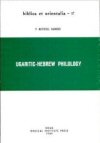
Ugaritic-Hebrew Philology
- Author: Mitchell Dahood
- Publisher: Pontificio Istituto Biblico
- Publication Date: 1989
- Pages: 89
Ugaritic-Hebrew Philology is structured as addenda and corrigenda to Cyrus Gordon’s Ugaritic Textbook. All three sections of Gordon’s work—grammar, texts, and glossary—are taken into consideration and commented upon in various details.
Mitchell Dahood, an American Jesuit and an authority on Semitic studies, was a professor at the Pontifical Bible Institute. He is the author of Psalms I, II, and III in the Anchor Yale Bible Commentaries.
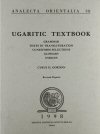
The Ugaritic Textbook is divided into three volumes. Volume 1 is a grammar. Volume 2 contains a great selection of texts in transliteration as well as a smaller selection of texts transcribed in the cuneiform script. The Logos edition will be able to link and scroll with the texts along with the Ugaritic Databank. Volume 3 is a glossary for looking up Ugaritic words, and contains a variety of indices to all three volumes.
Cyrus Gordon taught at New York University where he was director of the Center for Ebla Research. Gordon published numerous important works on the Near East, including The Ancient Near East, Ugaritic Textbook, Forgotten Scripts, and The Common Ground of Greek and Hebrew Civilization.
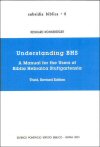
Understanding BHS is designed as a manual to be used in conjunction with the Biblia Hebraica Stuttgartensia (BHS). This elucidating volume is dedicating to a number of goals. Firstly, it seeks to enable beginners to gain access to the language of the text apparatus of BHS and to the Masoretic apparatus as well. Secondly, it documents the apparatus language of BHS in its entirety, providing references to the Old Testament text whenever possible. Lastly, it proposes a new concept of dealing with the apparatus of BHS, advancing the science of publishing critical editions of a text.
Understanding BHS achieves these goals through a translation of the items of the apparatus of BHS into English and through a complex but clear presentation of the relevant material in “paragraphs,” figures and indexes. All translations and presentations are linked together by a structured explanation. A selected bibliography is also provided for further study in depth.
Reinhard Wonneberger was born in 1946. He studied theology in Erlangen, Basel, and Heidelberg, where he received a doctorate in Theology in 1975 for his dissertation “Syntax und Exegese. Eine generative Theorie der griechischen Syntax und ihr Beitrag zur Auslegung des Neuen Testamentes, dargestellt an 2 Korinther 5,6f und Römer 3,21-26.” From 1977 to 1986 he taught Old Testament theology at the University of Hamburg. Since 1986 he has been working for Electronic Data Systems (Deutschland) GmbH in Russelsheim, and teaching Old Testament theology in his spare time at the University of Mainz.